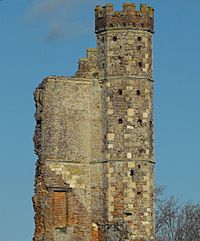Warblington Castle facts for kids
Quick facts for kids Warblington Castle |
|
|---|---|
| Hampshire, England | |

Part of the remains of Warblington Castle
|
|
| Coordinates | 50°50′40″N 0°57′57″W / 50.8444°N 0.9659°W |
| Type | Fortified manor house |
| Site information | |
| Condition | Ruined |
Warblington Castle or Warblington manor was a moated manor near Langstone in Havant parish, Hampshire. Most of the castle was destroyed during the English Civil War, leaving only a single gate tower, part of a wall, and a gateway. The property, now in the village of Warblington, is privately owned and does not allow for public access.
Details
Located near Langstone in Hampshire, the site was home to a medieval manor built in 1515 and 1525 and mostly destroyed in 1644.
The Saxon settlement, established here in the 7th century, is mentioned in the Domesday Book of 1086, indicating a population of about 120. The owner of the property at the time was Roger earl of Shrewsbury; after his death in 1094, it was inherited by his second son, Hugh. Records indicate that the owner in 1186 was William de Courci.
Some sources claim that the manor received a licence to crenellate in 1340 but this is disputed. The manor passed through several hands before coming into the possession of Richard Neville, 16th Earl of Warwick in the 15th century. Subsequently, the villagers were removed with the land becoming a private deer park for Neville.
With the execution of Edward Plantagenet, 17th Earl of Warwick by Henry VII the manor was confiscated and passed to the crown. In 1513 Henry VIII gave the manor to Margaret Pole, Countess of Salisbury who had a new moated manor built on the site. After Margaret Pole was attainted for treason temporary grants of the manor were made to William FitzWilliam, 1st Earl of Southampton and Thomas Wriothesley, 1st Earl of Southampton. Henry VIII then granted the manor to Sir Richard Cotton. In October 1551, Mary of Guise the widow of James V of Scotland stayed a night in the castle as the guest of Sir Richard Cotton. Edward VI visited the manor in 1552. Elizabeth I may have visited for two days in 1586. The Cotton family continued to hold the house until the English civil war.
In January 1643 Parliamentarians under Colonel Norton garrisoned the house with a force of between 40 and 80 men. It was besieged and taken by Lord Hopton although Colonel Norton managed to escape.
The Cotton family were Royalists which resulted in the manor being largely demolished by Parliamentarian forces. One turret of the gatehouse was left as an aid to navigation for ships in Langstone channel. The turret is octagonal in form and four stories in height. It is largely built from brick with stone dressing and battlements. After The Restoration, the property was returned to the Cotton family who built a farmhouse near the ruin. The latter is now Grade II listed.
Today, the turret, the arch of the gate and the drawbridge support in the moat still survive. The land remains private property. The remains of the castle is a grade II* listed building and a scheduled Monument. The Listing specifics define it as a "gateway tower, including the moulded stone arch of the gate, some of the south wall of the tower, a complete south-east octagonal stair turret, of 5 storeys, and part of the east wall (facing the courtyard)".
The castle is located within the Warblington Conservation Area which also contains the adjoining Old Farm House, an old cemetery, the Grade I listed St Thomas à Becket Church, Warblington and the Old Rectory.
As of May 2020, the owners of the castle were retired Olympic rowers Tom and Diana Bishop who reside in the seven bedroom Old Farm House on the property. At that time, the property also included four acres of gardens, an orchard and a swimming pool.


